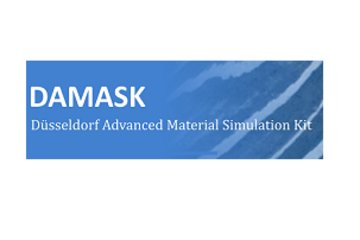All genres
201.
Talk
Microstructure Design from Liquidus Surfaces - The Value of Phase Diagrams for Materials Development. 64th Metal Research Colloquium, Department for Metal Research and Materials Testing of the University Leoben, Lech am Arlberg, Austria (2018)
202.
Talk
Atomic Scale Structural Transitions at Stacking Faults in C14–Fe2Nb Laves Phase. DFG Spring Meeting of the Condensed Matter Section, Berlin, Germany (2018)
203.
Talk
Effect of Metastable Co3Nb on Microstructural Evolution in Co–Nb Binary Alloys. JIM Spring Meeting 2018, Chiba, Japan (2018)
204.
Talk
Energetics of non-stoichiometric stacking faults in Fe–Nb alloys: An ab initio study. DPG-Frühjahrstagung 2018, Berlin, Germany (2018)
205.
Talk
Composition Dependence of Hardness and Strength of Cubic and Hexagonal NbCo2 Laves Phases. DGM Fachausschuss Intermetallische Phasen (FA‐IP), Max-Planck-Institut für Eisenforschung GmbH, Düsseldorf, Germany (2018)
206.
Talk
Theory-guided Design of Novel Fe–Al-based Superalloys. Intermetallics 2017, Educational Center Kloster Banz, Bad Staffelstein, Germany (2017)
207.
Talk
Fe–Al–Ni–Ti Strengthened by L21-(Fe,Ni)2TiAl Precipitates. Intermetallics 2017, Educational Center Kloster Banz, Bad Staffelstein, Germany (2017)
208.
Talk
Stacking Faults in C14 Fe2Nb Laves Phase. Intermetallics 2017, Educational Center Kloster Banz, Bad Staffelstein, Germany (2017)
209.
Talk
Impact of Magnetism on the Stability of Topologically Close-packed (TCP) Phases in Fe–Nb Alloys. Intermetallics 2017, Educational Center Kloster Banz, Bad Staffelstein, Germany (2017)
210.
Talk
About the Limits of Applicability of the Alkemade Theorem for the Construction of Ternary Liquidus Surfaces. CALPHAD XLVI Conference, Saint-Malo, France (2017)
211.
Talk
Precipitation-Strengthened High-Temperature Ferrite. 63rd Metal Research Colloquium organized by the Department for Metal Research and Materials Testing of the University Leoben, Lech am Arlberg, Austria (2017)
212.
Talk
Coarsening of Lamellar Microstructures. 63rd Metal Research Colloquium organized by the Department for Metal Research and Materials Testing of the University Leoben, Lech am Arlberg, Austria (2017)
213.
Talk
Fracture Toughness of Hexagonal and Cubic NbCo2 Laves Phases. Nanobrücken 2017, European Nanomechanical Testing Conference, University of Manchester, Manchester, UK (2017)
214.
Talk
Formation of Complex Intermetallic Phases from Supersaturated Co Solid Solution in a Co–3.9Nb Alloy. TMS 2017 Annual Meeting, San Diego, CA, USA (2017)
215.
Talk
Microstructure and Mechanical Behavior of Nb-based Nb–Al–Fe Alloys. TMS 2017 Annual Meeting, San Diego, CA, USA (2017)
216.
Talk
Stability Competition between Laves Phase Polytypes. Tokio Institute of Technology, Tokyo, Japan (2016)
217.
Talk
Stability Competition between Laves Phase Polytypes. Escola Politécnica da Universidade de São Paulo, University Sao Paulo, Sao Paulo, Brazil (2016)
218.
Talk
High-Temperature Phase Equilibria and Solidification Behaviour of Nb-rich Nb–Al–Fe Alloys. TOFA 2016, Discussion Meeting on Thermodynamics of Alloys, Santos, Brazil (2016)
219.
Talk
TEM Analysis of Deformation Structure in Fe2Nb Laves Phase. Seminar on Metal Materials, Prague, Czech Republic (2016)
220.
Talk
Deformation Mechanisms of Fe2Nb Laves Phase. Metal 2016
, Brno, Czech Republic (2016)











